B0041VYHGW EBOK (130 page)
Authors: David Bordwell,Kristin Thompson

Hitchcock’s style here is related to technical choices in the movie as a whole. For one thing, the shot of Uncle Charlie is the closest we ever come to him, so this tight framing gives the scene particular force. More generally, Hitchcock employs techniques that put us in the position of the characters. Throughout the film, he uses optical point of view, most often allowing us to share Little Charlie’s vantage point
(
8.14
,
8.15
).

8.14 Earlier in the film, when Little Charlie has begun to suspect her uncle, she pauses on the front doorstep.

8.15 Hitchcock then gives us an optical point-of-view shot of what makes her hesitate: Uncle Charlie holding her mother spellbound.
This pattern of stylistic choices is sustained throughout the dinner table monologue. The brief shot of Little Charlie reminds us of her position beside her uncle (
8.10
). But rather than have Uncle Charlie start his monologue by glancing at her, Hitchcock lets him speak to the others at the table, or perhaps only to himself (
8.11
,
8.12
). Only after Little Charlie’s offscreen outburst does Uncle Charlie turn to her—and us (
8.13
). Hitchcock has saved the most startling point-of-view moment for the end of the shot.
The style of this scene enhances the film’s pattern of restricted narration. After Uncle Charlie arrives in Santa Rosa, we get some private glimpses into his activities, but the scenes concentrate largely on Emmy’s family and particularly on Little Charlie. We know a bit more than she knows about her uncle. For example, from the start, we suspect that he’s being sought by the police, but we don’t know what they’re investigating. Later we learn that Uncle Charlie has torn a story out of the newspaper, but not until his niece finds it do we discover what he was trying to conceal. Slowly, along with Little Charlie, we discover that the Merry Widow Murderer is at large and that Uncle Charlie is a prime suspect.
So the overall form of the story’s development and the stylistic presentation in each scene work to put us close to Little Charlie. We know roughly what she knows, and we learn some key information when she does. In the dinner table scene, the developing story line and Hitchcock’s style combine to tie us even more tightly to Little Charlie. The moment when Uncle Charlie turns challengingly to the camera becomes a high point of this pattern.
Citizen Kane
In analyzing
Citizen Kane
’s narrative, we discovered that the film is organized as a search; a detective-like figure, the reporter Thompson, tries to find the significance of Kane’s last word, “Rosebud.” But even before Thompson appears as a character, we, the spectators, are invited to ask questions about Kane and to seek the answers.
The very beginning of the film sets up a mystery. After a fade-in reveals a “No Trespassing” sign, in a series of craning movements upward, the camera travels over a set of fences, all matched graphically in the slow dissolves that link the shots. There follows a series of shots of a huge estate, always with the great house in the distance
(
8.16
).
(This sequence depends largely on special effects; the house itself is a series of paintings, combined through matte work with three-dimensional miniatures in the foreground.) The gloomy lighting, the deserted setting, and the ominous music give the opening of the film the eerie uncertainty that we associate with mystery stories. These opening shots are connected by dissolves, making the camera seem to draw closer to the house although there is no forward camera movement. From shot to shot, the foreground changes, yet the lighted window remains in almost exactly the same position on the screen. Graphically matching the window from shot to shot already focuses our attention on it; we assume (rightly) that whatever is in that room will be important in initiating the story.
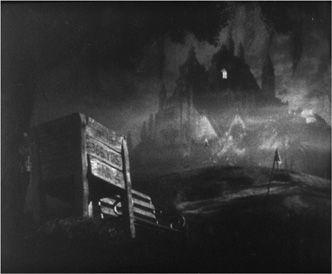
8.16 The opening of
Citizen Kane.
This pattern of our penetration into the space of a scene returns at other points in the film. Again and again, the camera moves toward things that might reveal the secrets of Kane’s character, as in the spectacular crane up the side of a nightclub to a skylight as Thompson goes to interview Susan Alexander
(
8.17
–
8.20
).
As the camera reaches the skylight, a dissolve and a crack of lightning shift the scene inside to another craning movement down to Susan’s table. (Actually, some of what seem to be camera movements were created in the laboratory using special effects; see
“Where to Go from Here”
at the end of the chapter.)
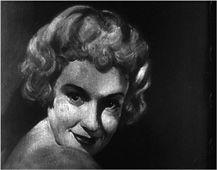
8.17 As this scene of
Citizen Kane
begins, the camera frames a poster of Susan Alexander on an outside wall of the nightclub …
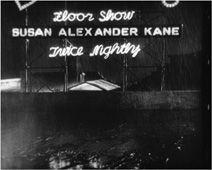
8.18 … then moves up the wall to the roof …

8.19 … forward and through the “El Rancho” sign …
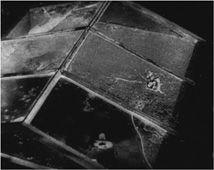
8.20 … and over to the skylight.
The opening scene and the introduction to El Rancho have some striking similarities. Each begins with a sign (“No Trespassing” and the publicity poster), and each moves us into a building to reveal a new character. The first scene uses a series of shots, whereas the second depends more on camera movement, but these different techniques are working to create a consistent pattern that becomes part of the film’s style. Later, Thompson’s second visit to Susan repeats the crane shots of the first. The second flashback of Jed Leland’s story begins with yet another movement into a scene. The camera is initially pointed at wet cobblestones. Then it tilts up and tracks in toward Susan coming out of a drugstore. Only then does the camera pan right to reveal Kane standing, splashed with mud, on the curb. This pattern of gradual movement into the story space not only suits the narrative’s search pattern but also creates curiosity and suspense.
As we have seen, films’ endings often contain variations of their beginnings. Toward the end of
Citizen Kane,
Thompson gives up his search for Rosebud. But after the reporters leave the huge storeroom of Xanadu, the camera begins to move over the great expanse of Kane’s collections. It cranes forward high above the crates and piles of objects
(
8.21
),
then moves down to center on the sled from Kane’s childhood
(
8.22
).
Then there is a cut to the furnace, and the camera again moves in on the sled as it is tossed into the fire. At last we are able to read the word “Rosebud” on the sled
(
8.23
).
The ending continues the pattern set up at the beginning; the film techniques create a penetration into the story space, probing the mystery of the central character.
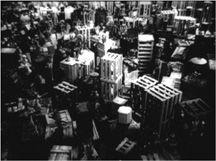
8.21 A crane shot near the end of
Citizen Kane
…